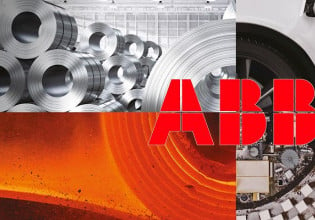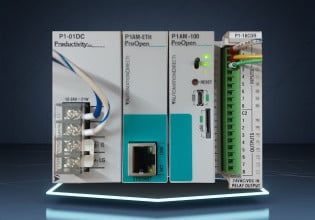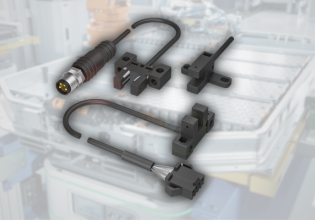Keyence Expands CL-3000 Series of Confocal Displacement Sensors
Keyence has expanded its catalog of displacement sensors to include explosion-proof, vacuum-proof, and long-range models. The new additions aim to deliver high-accuracy measurements in a greater variety of environments.
Several new additions have been added to Keyence’s CL-3000 Series confocal displacement sensors. Confocal displacement sensors are used to determine distances to high precision, making them useful for automated quality control operations. The latest models by Keyence are designed to handle challenging manufacturing environments, such as those under high vacuum or in areas that might contain flammable or explosive vapors and require explosion-proof sensors and equipment.

Artist demonstration of three Keyence CL-3000 Series sensors working in tandem. In this arrangement, they may be checking to ensure the blue film is of a consistent thickness. Image used courtesy of Keyence
Confocal Displacement Sensors
A confocal displacement sensor measures the reflected light from a surface and, based on the intensity of the reflection, can determine the distance between the sensor and the object. For this to work, the sensor emits light (typically a laser) and splits the beam. Half of the light travels through a lens system and is focused to a single point on the object’s surface. The other half of the light beam passes through a pinhole, which acts as a filter, removing all ambient light. The reflection is also passed through a pinhole, filtering out all reflections that are not at the proper distance. As a sensor, this can quickly determine “go/no go” criteria for quality control or, by adjusting the position of the pinhole, determine the distance between the sensor and the surface.

Artist’s conception of the Keyence CL-3000 focused on a single point. Image used courtesy of Keyence
Displacement Sensing in Industry
Quality control applications—such as those ensuring flatness, parallelism, detection of surface defects, the presence of coatings, whether screws have been tightened properly, etc.—can benefit from automated displacement sensing. For example, consider the thickness of a coating of paint applied to a metal part for corrosion resistance. If the paint does not adhere to the surface properly, it will be raised slightly. This change in thickness might go undetected to the naked eye, but to a confocal displacement sensor, the defect can be caught and remedied much more quickly.
The CL-3000 Series sensors provide high-accuracy measurements on a variety of surfaces (click image to enlarge). Image used courtesy of Keyence
The Keyence CL-3000 Series
The Keyence CL-3000 Series confocal displacement sensors are designed to function safely in harsh environments. Because some processes, such as certain coating methods, occur under vacuum, the CL-3000 is designed to operate in vacuum environments. Furthermore, painting applications, certain solvent applications, and others involve operation in a flammable or explosive vapor environment. Therefore, the newest CL-3000 sensors can operate safely near these vapors without igniting them.
The biggest advantage of the CL-3000 Series is the high accuracy, even when measuring the displacement of challenging surfaces. It performs even on transparent, glossy, or unfinished metals and ceramics and liquids that may cast multiple reflections or absorb some of the light.
Future Impact of the CL-3000
Any time a sensor, such as the CL-3000, can detect small variations in processing, the quality of the product improves drastically. The CL-3000 Series has the potential to improve the lifetime of some products by ensuring that protective coatings are of the proper thickness, fasteners are properly tightened, gaskets are properly positioned and not crushed unevenly, and other such excursions.
Keyence’s CL-3000 Series can potentially impact the quality control departments of virtually any manufacturing outfit.







